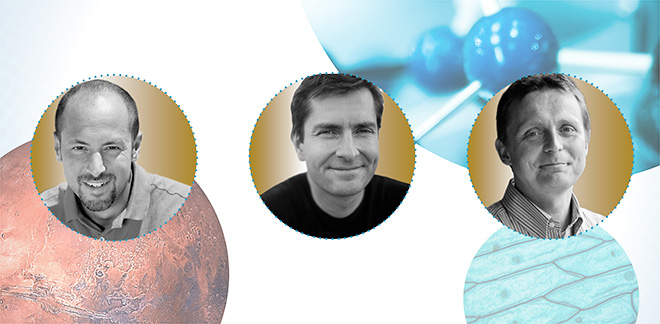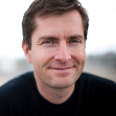
Three Pioneering Scientists Recognized for Breakthroughs in Astrophysics, Organic Chemistry, and Molecular Biology
NEW YORK – June 21, 2016– Three young scientists are being recognized for discovering novel ways to fight the most challenging human diseases and explore the depths of space with today’s announcement of the winners of the 2016 Blavatnik National Awards for Young Scientists.
The Awards, given annually by the Blavatnik Family Foundation and administered by the New York Academy of Sciences, honor the nation’s most exceptional young scientists and engineers, celebrating their extraordinary achievements and recognizing their outstanding promise. Each of the three National Laureates receives $250,000—the largest unrestricted cash award given to early-career scientists. This year’s Blavatnik National Laureates are:
- David Charbonneau, Professor of Astronomy, Harvard University: Dr. Charbonneau is honored for his numerous pioneering discoveries of exoplanets and for the development of novel observational methods that astronomers use to search for chemical fingerprints of life in space. Dr. Charbonneau’s recent results include a landmark discovery of an Earth-like planet orbiting a very nearby star, dubbed “arguably the most important planet ever found outside the solar system,” and the best-possible target for future exploration with the world’s most powerful observatories.
- Phil Baran, Professor of Chemistry, The Scripps Research Institute: Dr. Baran is honored for his transformative research in the field of natural product synthesis and his development of new synthetic methodology that enables chemists to design scalable, efficient, economically-viable synthetic routes to potential new drugs. One of the recent successes in the Baran laboratory is the synthesis of the plant-derived ingenol, derivatives of which have been approved by the U.S. Food and Drug Administration to treat skin cancer.
- Michael Rape, Professor of Cell and Developmental Biology, University of California, Berkeley: Dr. Rape is honored for his fundamental discoveries related to ubiquitylation – a process of cellular signaling dependent on the protein ubiquitin – which has emerged as a complex cellular language essential for information transfer and communication in nearly all organisms. By deciphering the ubiquitin code, Dr. Rape’s basic science work has opened the door to new and unique ways to manipulate ubiquitylation for next-generation therapies in oncology, immunology, and inflammation.
“The Blavatnik Family Foundation is pleased to recognize and promote the extraordinary work of our Laureates and to provide resources that support and encourage further exploration,” said Len Blavatnik, Founder and Chairman of Access Industries, head of the Blavatnik Family Foundation, and an Academy Board Governor. “I am encouraged about the future of scientific thought and look forward to how the Laureates and National Finalists will inspire the next generation of scientists.”
The three National Laureates were selected from a pool of nominations submitted by 148 of the nation’s leading universities and research institutions. Each institution was invited to nominate one physical scientist or engineer, one chemist, and one life scientist. The names of highly qualified nominees were also submitted by members of the Blavatnik Awards Scientific Advisory Council.
Starting with a pool of 308 nominations of exceptional faculty-rank researchers, the awards jury, composed of some of the world’s most eminent scientists and engineers, conducted a rigorous review. The judges first narrowed down the selection to 31 National Finalists, and then to three National Laureates.
“The science community is defined by innovators and pioneers, and this year’s National Laureates are leading the way in their fields,” said Dr. Brooke Grindlinger, Chief Scientific Officer, Scientific Programs & Blavatnik Awards, The New York Academy of Sciences. “The Academy is honored to collaborate with the Blavatnik Family Foundation to recognize these scientists. We congratulate the Laureates and National Finalists on their achievement.”
The three Laureates and 28 National Finalists will be honored at an annual awards ceremony on Monday, September 12, 2016, at the American Museum of Natural History in New York City.
Meet the 2016 Blavatnik National Laureates
 David Charbonneau, PhD
David Charbonneau, PhD
2016 Blavatnik Laureate in Physical Sciences & Engineering
Harvard University
PhD, Harvard University
BSc, University of Toronto
Pioneering the study of planets beyond our solar system
Growing up in a family of scientists, David Charbonneau’s interest in science was encouraged from a young age. As a scout, he used to take a star chart with him on canoe trips in Ontario, Canada. At the end of high school, he read ABrief History of Time by Stephen Hawking, and many of the ideas—relativity, quantum mechanics—seemed magical at the time, and compelled him to study further.
When he arrived at Harvard to begin graduate school in astronomy, Charbonneau was certain that he would work on theoretical astrophysics and cosmology. However, in 1995, the first exoplanet (a planet outside the solar system) orbiting a Sun-like star had just been discovered. This discovery posed so many simple, unanswered questions that Charbonneau was encouraged by his mentor, Dr. Robert Noyes, to try his first project in planets. He never looked back.
“For generations, humans have looked up at the stars and wondered if there existed inhabited worlds other than our own. We are the first generation in human history with the technological ability to answer that question,” says Dr. Charbonneau when asked about the inspiration behind his work.
At 41, David Charbonneau is considered very senior in exoplanet research—a field that has gone through a remarkable transformation from its infancy only 20 years ago into one of the most active and competitive directions in astrophysics. Charbonneau is being recognized for his literal out-of-this-world discoveries, which have opened the floodgates for search and discovery outside of our cosmic neighborhood. In 1999, Charbonneau, then still a graduate student, was the first to observe a transiting exoplanet–a planet that eclipses its parent star. The transit method proved to be extremely fruitful in discovering new exoplanets and granted new access to characterizing their properties–their atmospheres, weather, and the degree to which they are similar to Earth. Throughout his career, Charbonneau’s unifying purpose has been to develop new methods to answer key questions about exoplanets, and a number of his methods have become standards of the field.
With more than 3,000 exoplanets discovered thus far, one major question remains unanswered: Is there life elsewhere in space? To answer this question, Earth-like planets and their atmospheres need to be studied for the presence of elements that indicate life. Ever the celestial detective, one of Charbonneau’s latest projects is MEarth, a network of eight robotic telescopes in Arizona and Chile, which searches for candidate planets orbiting the closest and smallest stars to undertake more detailed studies. Just last year, MEarth discovered a rocky planet approximately the same size as the Earth, transiting a very nearby star. This small, rocky planet was dubbed “arguably the most important planet ever found outside the solar system,” because astronomers will be able to scrutinize its atmosphere with the upcoming James Webb Space Telescope.
The big question Dr. Charbonneau is working on now is the detection of atmospheric biomarkers, such as oxygen–the molecules that we can detect in the atmosphere of a distant world that might permit us to infer the presence of life.
 Phil Baran, PhD
Phil Baran, PhD
2016 Blavatnik Laureate in Chemistry
The Scripps Research Institute
PhD, The Scripps Research Institute
BS, New York University
Transforming organic synthesis for medicinal and industry applications
A New Jersey native, Phil Baran spent his early years in Florida, where he first became interested in science, particularly in his high school astronomy class. But it was not until he discovered chemistry, his life-long passion, that he found an outlet for his creative energies. As an undergraduate at New York University working on the design and synthesis of artificial photosynthetic systems, Baran would often work through the night and in the morning surprise his mentor, David Schuster, with new results.
Today, Dr. Baran is transforming what was thought to be a mature field of natural product synthesis, solving some of the toughest problems that have defied chemists for over a decade. The earliest medicines known to man were natural products–compounds derived from natural sources such as plants or micro-organisms. Available in only the smallest of quantities, the modern chemists’ conundrum has long been how to efficiently and economically synthesize these compounds in practical quantities for routine use. Dr. Baran has established a breakthrough new approach for efficient, commercially-scalable syntheses of biologically active natural products, in the process inventing new reagents and reactions that have swiftly found widespread use in pharmaceutical and agrochemical industries seeking easier, cheaper, and greener chemistry. His ultimate goal for each synthesis is to obtain larger quantities of these natural products than can be feasibly extracted from their natural sources. This better equips pharmaceutical companies to investigate the therapeutic properties as well as ensure that the compounds are both stable and safe enough for use in drug development.
“If you think of medicines as planets, our lab is building rockets,” says Dr. Baran when asked about the ultimate goal of his research.
Over the last decade, the Baran Laboratory has recorded a remarkable number of accomplishments, completing the syntheses of dozens of molecules from over 15 classes of highly complex and biologically active natural products. Dr. Baran’s approach to simplifying total synthesis and rendering it practical (gram-scale) represents a sea-change in the way such efforts are undertaken. One of the recent successes in the Baran Laboratory is the synthesis of the plant-derived ingenol, derivatives of which have been approved by the U.S. Food and Drug Administration to treat skin cancer.
In 2011, Dr. Baran co-founded Sirenas Marine Discovery, to generate marine-inspired pre-clinical drug leads for larger biotech and pharmaceutical companies targeting cancer, HIV, and infectious diseases. The company aims to bridge the gap between private enterprise and academia, combining its chemistry expertise and resources with collaborative and flexible business models with both institutions and industry partners. In 2013, Sirenas was voted a San Diego top 30 “Cool Company” by the San Diego Venture Group.
What next?
“Now is perhaps some of the most interesting times of our lab,” says Dr. Baran. “On the methodology front, we have invented a method that allows chemists to dramatically expand the chemical space they can explore in a simple and cost-effective fashion. On the synthesis front, this year we have completed half a dozen natural product syntheses in a fraction of the number of steps that were previously required.”
Dr. Baran’s creative approach has led to a number of useful methodologies that have been broadly utilized by both academic and industrial chemists. His accomplishments show great promise in the development of new drugs and therapies that can help cure and manage disease.
 Michael Rape, PhD
Michael Rape, PhD
2016 Blavatnik Laureate in Life Sciences
University of California, Berkeley
PhD, Max Planck Institute of Biochemistry
Diploma, Bayreuth University
Translating basic science into new approaches for drug discovery
At the age of 12, Michael Rape created his first laboratory in the basement of his parents’ house, interested in exploring the complex relationship between nature, environmental pollution, and human health. Moved by the stories of his friends who suffered from illnesses caused by air pollution in his native Bavaria, a highly industrialized state in south-east Germany, he pledged to make his own contribution to our understanding of how nature, human development, and diseases are linked together. Today, Dr. Rape’s research is still following this path.
At the core of his work is understanding signal transduction within cells and the “words” and “phrases” used by cells, to decode the “vocabulary” or “sentences” that influence the activity and behavior of the cell.
“We are trying to dissect principles of information transfer in human cells that shed light on fundamental mechanisms of early human development and can be translated into novel therapies against developmental diseases and cancer,” says Dr. Rape of his group’s work.
The Rape Lab studies a complex process critical to nearly all organisms: ubiquitylation. The term describes the attachment of a regulatory protein called ubiquitin onto other proteins. This vital system pre-emptively “tags” damaged or bad proteins for destruction in an effort to keep cells healthy. Dr. Rape, through use of elegant biochemical, biophysical, and cellular techniques, has made groundbreaking insights into ubiquitin and its role in regulating fundamental processes in human development and disease, including cell division and survival. Abnormal ubiquitylation contributes to a variety of diseases, including cancer and neurodegenerative diseases such as ALS and Parkinson’s. By cracking the ubiquitin code, Dr. Rape’s basic science work has opened the door to new and unique ways to manipulate ubiquitylation for next-generation therapies in oncology, immunology, and inflammation.
In 2009, Dr. Rape co-founded a biotechnology company Nurix, to develop next-generation therapies that work by modulating the protein machinery of the cell. Dr. Rape and his team pioneered an innovative approach that attaches small molecules to oncogenic proteins. After the cancer cells are “tagged,” they are redirected for ubiquitylation and degradation and then ultimately destroyed. In 2015, the company was recognized by Forbes as one of its top startups. Nurix’s recent partnership with Celgene, a leading pharmaceutical company, will allow researchers to bring their first therapeutic compounds to the clinical stage. In doing so, Dr. Rape will have successfully translated results from basic scientific work into new approaches for drug discovery.